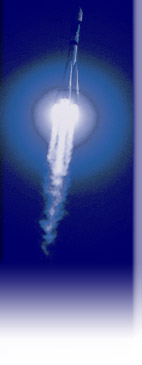Starsem and Soyuz score another success: GIOVE-A is in orbit
for Europe's new Galileo satellite-based navigation system
December 28, 2005
Starsem's 15th commercial flight marked another on-target success as the European GIOVE-A navigation satellite was placed in orbit by a Soyuz-Fregat vehicle launched from Baikonur Cosmodrome in Kazakhstan.
 |
The two service platforms on launch pad no. 6
are retracted to their stowed position at 30 min.
before liftoff of Starsem's Soyuz-Fregat with
the GIOVE-A payload. Click on the image
for a larger version. (Photo ©: ESA). |
|
The mission was another important launch for Starsem, with the cube-shaped GIOVE-A spacecraft serving as the first of two demonstrator satellites for Europe's new Galileo space-based navigation and positioning system.
"This is a new success for the Soyuz launch vehicle and is an excellent success for Europe, marking the Galileo project's startup," said Starsem Chief Executive Officer Jean-Yves Le Gall. "I want to once again thank the European Commission and the European Space Agency for their confidence in Starsem."
Le Gall – who also is CEO for Starsem affiliate company Arianespace, which operates the Ariane 5 – noted that with today's launch, Starsem and Arianespace orbited a combined total of 11 commercial spacecraft in 2005, more than all of their competitors combined. This includes three Starsem Soyuz flights (which carried GIOVE-A, the Venus Express interplanetary probe for Europe, and the Galaxy 14 telecommunications satellite for U.S. operator PanAmSat), plus five Ariane 5 missions that lofted eight primary payloads.
Today's mission also was the 15th commercial flight for Starsem, which has logged a perfect launch record since its first mission in February 1999.
"We are extremely pleased with today's launch: GIOVE-A is now in the ideal Medium Earth Orbit that the Galileo system was designed for," said Marco Falcone, the European Space Agency's project system manager. "We acknowledge the very good job by Starsem."
 |
Carrying its GIOVE-A payload,
the Soyuz-Fregat accelerates
away from Baikonur Cosmo- drome's launch pad no. 6.
Click on the image for a
larger version. (Photo ©: ESA). |
|
GIOVE-A will carry out vital in-orbit validation tasks for the Galileo system, including measuring the radiation environment in the Medium Earth Orbit (MEO) for Galileo satellites, testing the most critical Galileo technologies (on-board atomic clocks and signal generators), validating the Galileo signal design's novel features, and securing access to the navigation system frequencies allocated by the International Telecommunications Union (ITU).
The second Galileo demonstrator spacecraft - GIOVE-B - also will be launched by Starsem, with its flight targeted in 2006. Eventually, the full Galileo constellation will consist of 30 satellites.
Today's liftoff of the Soyuz with GIOVE-A occurred right on schedule at 11:19 a.m. local time from the Baikonur Cosmodrome (05h19 GMT, 8:19 a.m. in Moscow and 6:19 a.m. in Paris). The launcher climbed into a sunny sky with only thin scattered cloud cover, and headed downrange on a northeast trajectory that passed over Kazakhstan and Russia.
The GIOVE-A spacecraft and its Fregat upper stage were separated as planned from Soyuz at just under nine minutes into the flight.
Fregat subsequently performed three separate burns, releasing GIOVE-A into the planned 23,222-km. circular orbit at approximately 3 hours 42 minutes after liftoff.
Telemetry was received by GIOVE-A manufacturer Surrey Satellite Technology immediately after the spacecraft's separation, confirming it was deployed on-target and in a stable condition.
For additional information on the successful Starsem GIOVE-A launch, review the previous updates, along with the post-mission press release and Starsem's official launch kit.
Press release:
- Read our press release about this successful Starsem mission.
Launch kit:
- Download the Starsem Starsem GIOVE-A launch kit for additional information on the mission and the Soyuz launch system. (2,344 Kb)







